Published by Stash Books, an imprint of C&T Publishing, Inc., P.O. Box 1456, Lafayette, CA 94549 Publisher: Amy Marson Creative Director: Gailen Runge Art Director / Book Designer: Kristy Zacharias Editor: Liz Aneloski Technical Editors: Doreen Hazel, Teresa Stroin, and Ann Haley Production Coordinator: Rue Flaherty Production Editor: Joanna Burgarino Illustrator: Mary E. Flynn Photo Assistant: Mary Peyton Peppo Cover photography by Nissa Brehmer; Instructional photography by Diane Pedersen, unless otherwise noted Tools and Supplies Sewing Machines BASIC MECHANICAL SEWING MACHINE Simple, motorized machine that makes straight, zigzag, and usually a few decorative stitches. Stitch settings are controlled manually with knobs. COMPUTERIZED SEWING MACHINE Makes a wide variety of utility and decorative stitches.  EMBROIDERY MACHINE Stitches digitized embroidery design files.
EMBROIDERY MACHINE Stitches digitized embroidery design files.  EMBROIDERY MACHINE Stitches digitized embroidery design files.
EMBROIDERY MACHINE Stitches digitized embroidery design files.
It can be a stand-alone machine or a module that works in combination with a computerized machine. 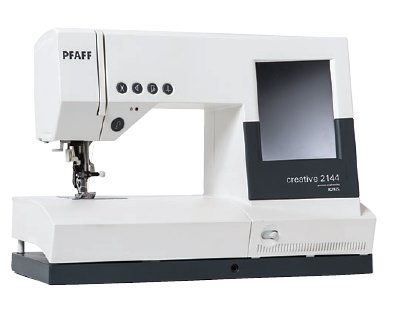 QUILTING MACHINE Features a larger work area and more advanced feeding mechanisms than a standard computerized machine. OVERLOCK MACHINE Also known as a serger. Utilizes multiple threads to simultaneously stitch and finish seams. Features include a blade for trimming edges prior to stitching and a stitch finger for creating rolled hems.
QUILTING MACHINE Features a larger work area and more advanced feeding mechanisms than a standard computerized machine. OVERLOCK MACHINE Also known as a serger. Utilizes multiple threads to simultaneously stitch and finish seams. Features include a blade for trimming edges prior to stitching and a stitch finger for creating rolled hems.  GROOVED FEET Facilitate centered passage of trims and thick specialty stitches.
GROOVED FEET Facilitate centered passage of trims and thick specialty stitches. 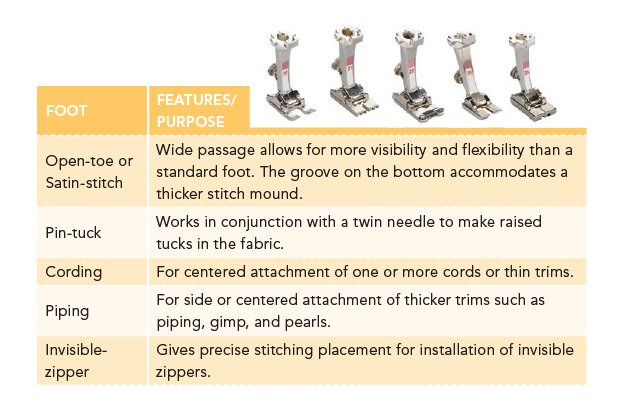 BUTTONHOLING AND BUTTON-SEWING FEET Designed to automatically make identical buttonholes (see One-Step Buttonholes, ).
BUTTONHOLING AND BUTTON-SEWING FEET Designed to automatically make identical buttonholes (see One-Step Buttonholes, ).  BUTTONHOLING AND BUTTON-SEWING FEET Designed to automatically make identical buttonholes (see One-Step Buttonholes, ).
BUTTONHOLING AND BUTTON-SEWING FEET Designed to automatically make identical buttonholes (see One-Step Buttonholes, ).
HEMMING AND RUFFLING FEET Direct one or more layers of fabric into the proper position for stitching.  NONSTICK AND WALKING FEET Allow for smooth sewing of sticky, shifty, thick, or otherwise challenging fabrics (such as leather, suede, velvet, and oilcloth).
NONSTICK AND WALKING FEET Allow for smooth sewing of sticky, shifty, thick, or otherwise challenging fabrics (such as leather, suede, velvet, and oilcloth). 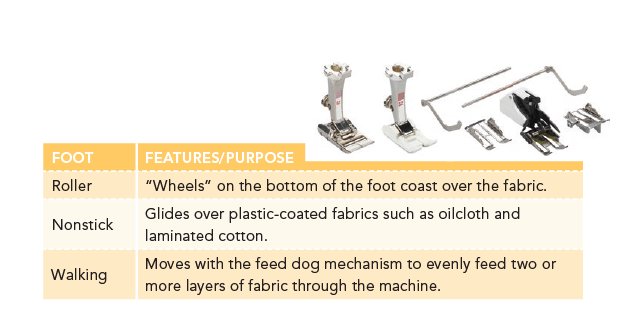 FREE-MOTION FEET Allow for user-controlled stitching with dropped feed dogs.
FREE-MOTION FEET Allow for user-controlled stitching with dropped feed dogs. 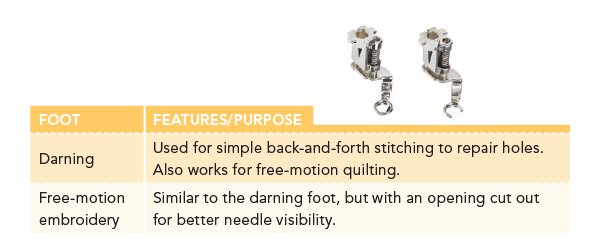 Cutting Tools GENERAL SEWING SCISSORS Ideal size and angle for snipping thread and fabric during the sewing process. DRESSMAKERS SHEARS Large, heavy scissor angled for cutting out large pieces of fabric. PINKING SHEARS Large scissor with notched blades that produces nonfraying zigzag cuts.
Cutting Tools GENERAL SEWING SCISSORS Ideal size and angle for snipping thread and fabric during the sewing process. DRESSMAKERS SHEARS Large, heavy scissor angled for cutting out large pieces of fabric. PINKING SHEARS Large scissor with notched blades that produces nonfraying zigzag cuts.
APPLIQU SCISSORS Small, with a duck bill that acts as a guide for close cutting while protecting fabric. THREAD SNIPS Small spring-loaded clipper for quick, efficient thread snipping. EMBROIDERY SCISSORS Small, with sharp blades that fit into hard-to-reach areas to snip threads with precision. ROTARY CUTTER Circular blade that works in conjunction with a clear cutting ruler and a rotary cutting mat. Ideal for making straight cuts of fabric. Pressing Tools IRON AND IRONING BOARD To smooth fabric and press seams during the sewing process.
SLEEVE BOARD Small tabletop ironing board that fits into cylindrical shapes, such as sleeves, for crease-free pressing. SEAM ROLL Stuffed fabric roll similar to a sleeve board but smaller and more flexible. May also be wooden. TAILORS HAM Tightly stuffed fabric pillow with a wide end and a narrow end, used for pressing darts and curved seams. PRESSING CLOTH Placed over fabric while pressing to protect the fabric from the surface of the iron. TEFLON PRESSING SHEET Heat-resistant, nonstick material that allows for the application of double-sided fusible products to fabric.
Also useful as a see-through pressing cloth. Marking Tools Follow manufacturers directions when using removeable marking tools. 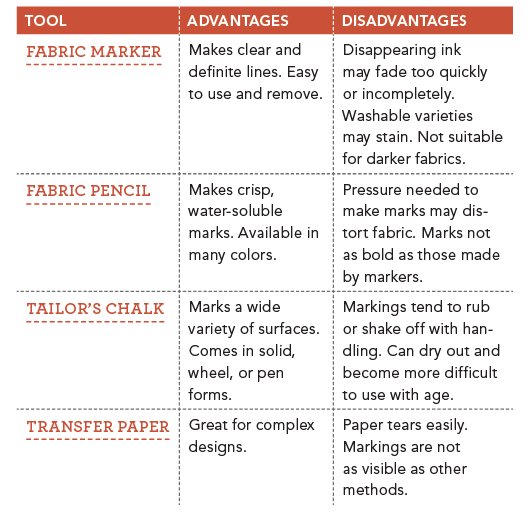 Sewing Machine Needles Needle Size Needle size is usually identified by two numbers: a top large number that is the shaft diameter in millimeters (European sizing) and a smaller bottom number that indicates standard U.S. sizing.
Sewing Machine Needles Needle Size Needle size is usually identified by two numbers: a top large number that is the shaft diameter in millimeters (European sizing) and a smaller bottom number that indicates standard U.S. sizing. 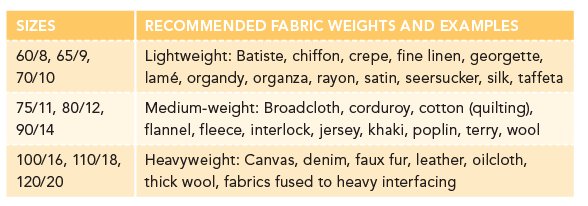 Needle Type Needle sharpness, silhouette, and eye shape are optimized for different fabrics and applications. General home sewing needles are designated by the letter H.
Needle Type Needle sharpness, silhouette, and eye shape are optimized for different fabrics and applications. General home sewing needles are designated by the letter H.
A second letter may be assigned to denote the purpose and/or specific fabric. 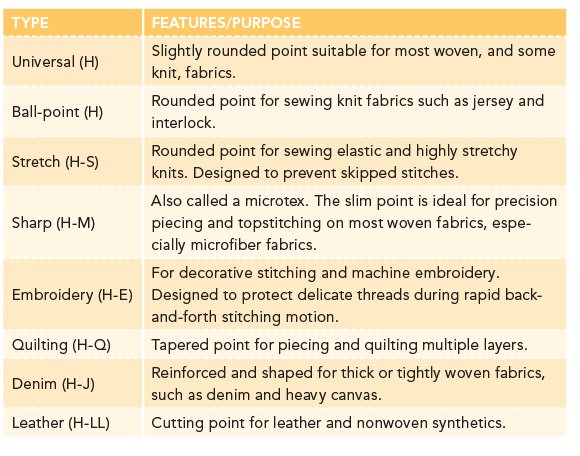 Specialty Needles Designed for specific stitches and threads, these needles include hem-stitch, top-stitch, and metallic needles. Twin and triple needles create rows of parallel stitching. Straight Pins All-purpose pins are sharp-pointed, about 0.6mm thick, and 12 long. Specialty pins vary in size and point style. EXTRA FINE For sheer or very delicate fabrics.
Specialty Needles Designed for specific stitches and threads, these needles include hem-stitch, top-stitch, and metallic needles. Twin and triple needles create rows of parallel stitching. Straight Pins All-purpose pins are sharp-pointed, about 0.6mm thick, and 12 long. Specialty pins vary in size and point style. EXTRA FINE For sheer or very delicate fabrics.
Also called silk pins or satin pins. BALL-POINT Rounded tip specifically for knit fabrics T-PIN Thick, with a T-shaped head. For heavy fabrics such as upholstery. APPLIQU Short and ideal for applying small trims and embellishments. Pinhead style is mostly a matter of personal preference. Ball-shaped plastic heads are the most common, as they are easy to see and manipulate.
Metal and glass heads are more heat-resistant. Flat plastic heads reduce bulk and distortion of fabric. 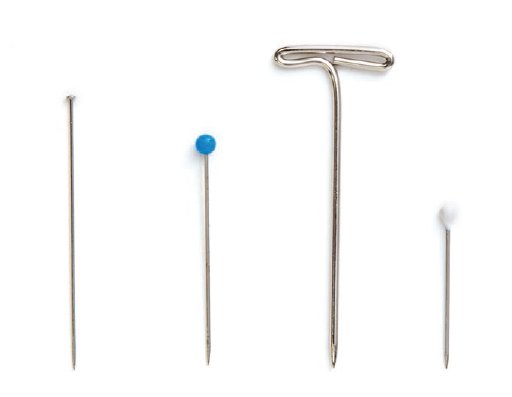 Thread Thread Fiber Composition Fiber content determines the stretchiness, sheen, and strength of the thread.
Thread Thread Fiber Composition Fiber content determines the stretchiness, sheen, and strength of the thread.  Thread Weight Standard measuring system: the thicker the thread, the lower the weight designation.
Thread Weight Standard measuring system: the thicker the thread, the lower the weight designation. 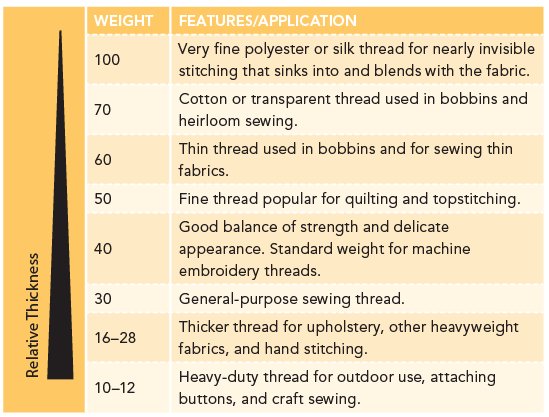 Elastic Elastic Fiber Content Rubber or spandex is combined with a fiber to make elastic.
Elastic Elastic Fiber Content Rubber or spandex is combined with a fiber to make elastic. 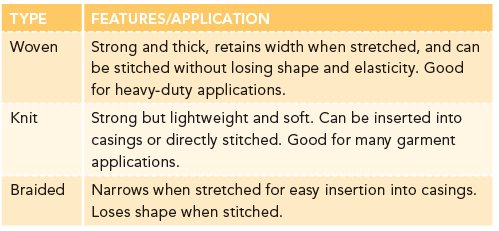 Elastic Style Elastic comes in many styles, so choose the one thats right for your application.
Elastic Style Elastic comes in many styles, so choose the one thats right for your application. 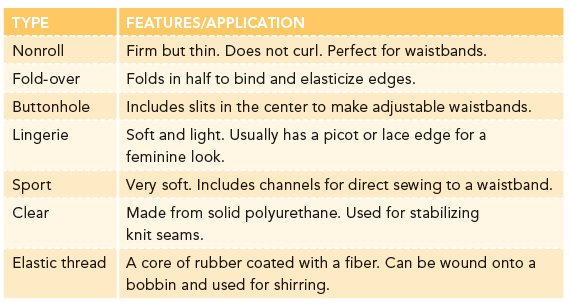
Next page
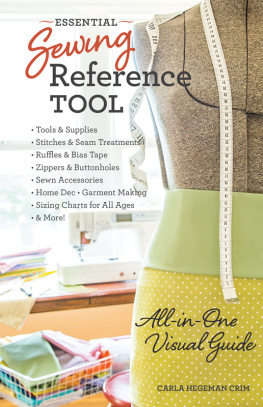

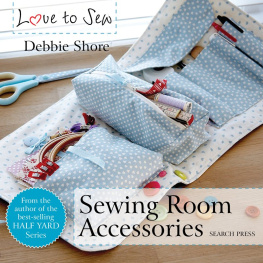
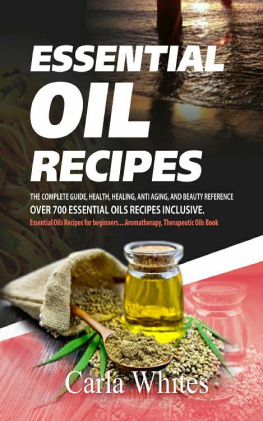
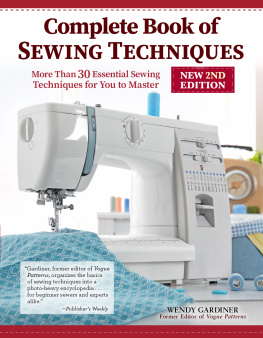

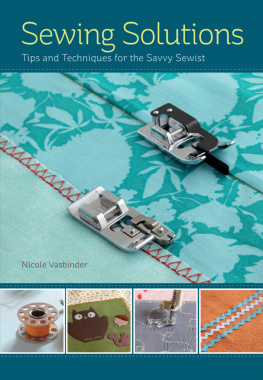
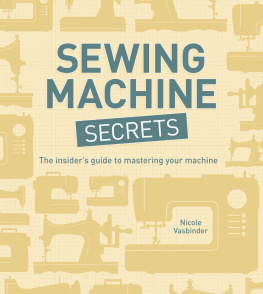

 EMBROIDERY MACHINE Stitches digitized embroidery design files.
EMBROIDERY MACHINE Stitches digitized embroidery design files.  QUILTING MACHINE Features a larger work area and more advanced feeding mechanisms than a standard computerized machine. OVERLOCK MACHINE Also known as a serger. Utilizes multiple threads to simultaneously stitch and finish seams. Features include a blade for trimming edges prior to stitching and a stitch finger for creating rolled hems.
QUILTING MACHINE Features a larger work area and more advanced feeding mechanisms than a standard computerized machine. OVERLOCK MACHINE Also known as a serger. Utilizes multiple threads to simultaneously stitch and finish seams. Features include a blade for trimming edges prior to stitching and a stitch finger for creating rolled hems.  GROOVED FEET Facilitate centered passage of trims and thick specialty stitches.
GROOVED FEET Facilitate centered passage of trims and thick specialty stitches.  BUTTONHOLING AND BUTTON-SEWING FEET Designed to automatically make identical buttonholes (see One-Step Buttonholes, ).
BUTTONHOLING AND BUTTON-SEWING FEET Designed to automatically make identical buttonholes (see One-Step Buttonholes, ).  NONSTICK AND WALKING FEET Allow for smooth sewing of sticky, shifty, thick, or otherwise challenging fabrics (such as leather, suede, velvet, and oilcloth).
NONSTICK AND WALKING FEET Allow for smooth sewing of sticky, shifty, thick, or otherwise challenging fabrics (such as leather, suede, velvet, and oilcloth).  FREE-MOTION FEET Allow for user-controlled stitching with dropped feed dogs.
FREE-MOTION FEET Allow for user-controlled stitching with dropped feed dogs.  Cutting Tools GENERAL SEWING SCISSORS Ideal size and angle for snipping thread and fabric during the sewing process. DRESSMAKERS SHEARS Large, heavy scissor angled for cutting out large pieces of fabric. PINKING SHEARS Large scissor with notched blades that produces nonfraying zigzag cuts.
Cutting Tools GENERAL SEWING SCISSORS Ideal size and angle for snipping thread and fabric during the sewing process. DRESSMAKERS SHEARS Large, heavy scissor angled for cutting out large pieces of fabric. PINKING SHEARS Large scissor with notched blades that produces nonfraying zigzag cuts. Sewing Machine Needles Needle Size Needle size is usually identified by two numbers: a top large number that is the shaft diameter in millimeters (European sizing) and a smaller bottom number that indicates standard U.S. sizing.
Sewing Machine Needles Needle Size Needle size is usually identified by two numbers: a top large number that is the shaft diameter in millimeters (European sizing) and a smaller bottom number that indicates standard U.S. sizing.  Needle Type Needle sharpness, silhouette, and eye shape are optimized for different fabrics and applications. General home sewing needles are designated by the letter H.
Needle Type Needle sharpness, silhouette, and eye shape are optimized for different fabrics and applications. General home sewing needles are designated by the letter H. Specialty Needles Designed for specific stitches and threads, these needles include hem-stitch, top-stitch, and metallic needles. Twin and triple needles create rows of parallel stitching. Straight Pins All-purpose pins are sharp-pointed, about 0.6mm thick, and 12 long. Specialty pins vary in size and point style. EXTRA FINE For sheer or very delicate fabrics.
Specialty Needles Designed for specific stitches and threads, these needles include hem-stitch, top-stitch, and metallic needles. Twin and triple needles create rows of parallel stitching. Straight Pins All-purpose pins are sharp-pointed, about 0.6mm thick, and 12 long. Specialty pins vary in size and point style. EXTRA FINE For sheer or very delicate fabrics. Thread Thread Fiber Composition Fiber content determines the stretchiness, sheen, and strength of the thread.
Thread Thread Fiber Composition Fiber content determines the stretchiness, sheen, and strength of the thread.  Thread Weight Standard measuring system: the thicker the thread, the lower the weight designation.
Thread Weight Standard measuring system: the thicker the thread, the lower the weight designation.  Elastic Elastic Fiber Content Rubber or spandex is combined with a fiber to make elastic.
Elastic Elastic Fiber Content Rubber or spandex is combined with a fiber to make elastic.  Elastic Style Elastic comes in many styles, so choose the one thats right for your application.
Elastic Style Elastic comes in many styles, so choose the one thats right for your application. 